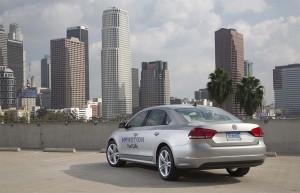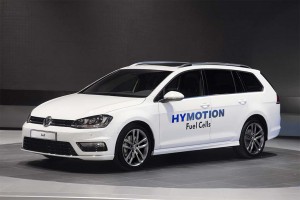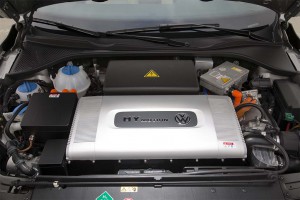Volkswagen is joining the rapidly growing list of makers developing hydrogen-powered alternatives, the concept model making its debut at the Los Angeles Auto Show starting out as a version of maker’s popular Golf family.
VW notes the various Golf models now cover all key powertrain options, from diesel to gas, as well as a hybrid, pure battery-electric and now, a hydrogen version. Dubbed the Golf SportWagen HyMotion, it would become be the first fuel-cell vehicle to use VW’s new MQB small car platform if eventually put into production.
The Golf HyMotion’s debut at the LA show was far from coincidental. Hydrogen power has been gaining traction in recent years as an alternative that could sidestep the limits of battery propulsion – though hydrogen has issues of its own. A number of other automakers, including Honda, Toyota and VW sibling Audi are also spotlighting their fuel cell efforts at this year’s show.
In concept form, VW says the Golf SportWagen HyMotion can get up to 310 miles of zero-emission driving before needing to refuel. The big challenge, if and when the concept is put into production, will be finding the necessary hydrogen pumps. Though the lightweight gas may be the most abundant element in the universe, it is not readily available as a fuel.

The HyMotion uses Volkswagen's MQB small car architecture, which means it could be under consideration for production.
There are still only a handful of pumps in the U.S., most of them located in Southern California, which is why Hyundai, Honda and Toyota plan to limit fuel-cell vehicle sales, at least initially, to that region. But there are efforts underway to grow the so-called hydrogen infrastructure, both here and abroad.
At its LA Auto Show news conference, Honda announced a new partnership – backed by a $14 million investment – to set up more pumps around California. The maker’s own hydrogen car is due to market in 2016.
VW isn’t talking about specific production plans, but like other makers it is emphasizing hydrogen’s potential advantages over battery power. That includes significantly longer range and the ability to refuel in less than five minutes, compared to the hours needed for a battery-car to recharge.
The idea of offering a hydrogen Golf was taken into consideration even as the current compact model was being developed, a VW release noted. That allowed the maker to bury the special fuel tanks and other hardware in a way that will yield “the same amount of space as in all other versions of the (Golf) model.”
(New VW Golf R “Variant” Gets the Go. For more, Click Here.)
A fuel-cell stack combines compressed hydrogen with oxygen from the air to produce water vapor and a flow of electric current. That power is then used to run a motor drive system similar to that found in a battery-car.
(Click Here for details about how automakers are counting on technology.)
The VW stack produces about 100 kilowatts of energy, or roughly 130 horsepower. Due to the torque nature of electric propulsion, that will yield a more aggressive launch than the numbers might suggest. The VW Golf SportWagen HyMotion will launch from 0 to 100 kmh, or 62.5 mph, in 10.0 seconds, roughly in line with the current Chevrolet Volt plug-in hybrid.
(To see more about Audi’s edgy Prologue and its future impact, Click Here.)
Volkswagen is looking at various ways to integrate hydrogen power into its line-up. The Audi brand also unveiled the A7 h-tron Sportback Quattro pairing its hydrogen fuel-cell stack with an 8.8 kilowatt lithium-ion battery. That plug-in hybrid is rated at 342 miles of range, with a 0 to 60 mph launch time of 7.8 seconds.
Both makers have suggested they could have production hydrogen cars on the market in the coming years, though they have yet to set hard dates.


